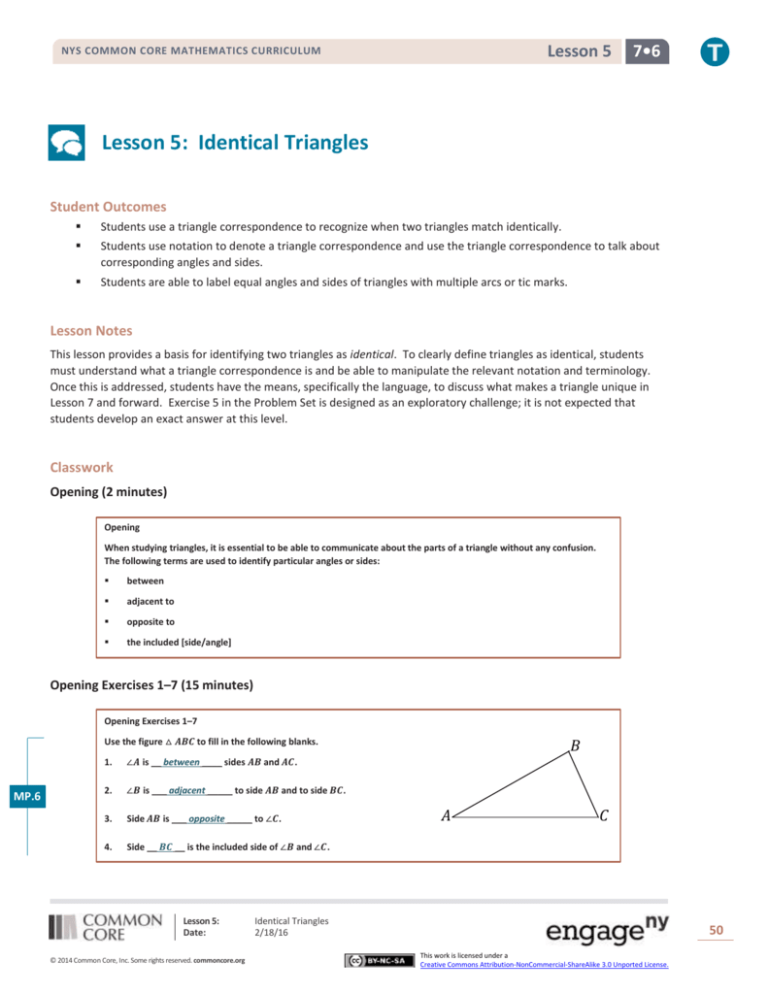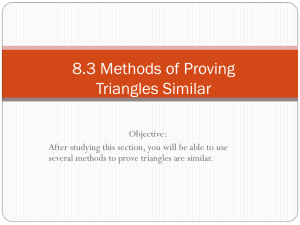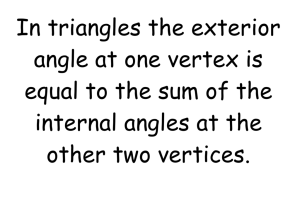
Lesson 5
NYS COMMON CORE MATHEMATICS CURRICULUM
7•6
Lesson 5: Identical Triangles
Student Outcomes
Students use a triangle correspondence to recognize when two triangles match identically.
Students use notation to denote a triangle correspondence and use the triangle correspondence to talk about
corresponding angles and sides.
Students are able to label equal angles and sides of triangles with multiple arcs or tic marks.
Lesson Notes
This lesson provides a basis for identifying two triangles as identical. To clearly define triangles as identical, students
must understand what a triangle correspondence is and be able to manipulate the relevant notation and terminology.
Once this is addressed, students have the means, specifically the language, to discuss what makes a triangle unique in
Lesson 7 and forward. Exercise 5 in the Problem Set is designed as an exploratory challenge; it is not expected that
students develop an exact answer at this level.
Classwork
Opening (2 minutes)
Opening
When studying triangles, it is essential to be able to communicate about the parts of a triangle without any confusion.
The following terms are used to identify particular angles or sides:
between
adjacent to
opposite to
the included [side/angle]
Opening Exercises 1–7 (15 minutes)
Opening Exercises 1–7
B
Use the figure △ 𝑨𝑩𝑪 to fill in the following blanks.
MP.6
1.
∠𝑨 is __ between ____ sides 𝑨𝑩 and 𝑨𝑪.
2.
∠𝑩 is ___ adjacent _____ to side 𝑨𝑩 and to side 𝑩𝑪.
3.
Side 𝑨𝑩 is ___ opposite _____ to ∠𝑪.
4.
Side __ 𝑩𝑪 __ is the included side of ∠𝑩 and ∠𝑪.
Lesson 5:
Date:
© 2014 Common Core, Inc. Some rights reserved. commoncore.org
A
C
Identical Triangles
2/18/16
50
This work is licensed under a
Creative Commons Attribution-NonCommercial-ShareAlike 3.0 Unported License.
Lesson 5
NYS COMMON CORE MATHEMATICS CURRICULUM
MP.6
5.
∠_𝑩___ is opposite to Side 𝑨𝑪.
6.
Side 𝑨𝑩 is between angles ∠_𝑨___ and ∠_𝑩___.
7.
What is the included angle of 𝑨𝑩 and 𝑩𝑪? ∠_𝑩__.
7•6
Y
Now that we know what to call the parts within a triangle, we
consider how to discuss two triangles. We need to compare the
parts of the triangles in a way that is easy to understand. To
establish some alignment between the triangles, the vertices of
the two triangles are paired up. This is called a correspondence.
Specifically, a correspondence between two triangles is a
pairing of each vertex of one triangle with one (and only one)
vertex of the other triangle. A correspondence provides a
systematic way to compare parts of two triangles.
B
A
C
X
Z
Figure 1
In Figure 1, we can choose to assign a correspondence so that 𝑨
matches to 𝑿, 𝑩 matches to 𝒀, and 𝑪 matches to 𝒁. We notate this correspondence with double-arrows: 𝑨 ↔ 𝑿, 𝑩 ↔ 𝒀,
and 𝑪 ↔ 𝒁. This is just one of six possible correspondences between the two triangles. Four of the six correspondences
are listed below; find the remaining two correspondences.
𝑨
𝑩
𝑪
𝑿
𝒀
𝒁
𝑨
𝑩
𝑪
𝑿
𝒀
𝒁
𝑨
𝑩
𝑪
𝑿
𝒀
𝒁
𝑨
𝑩
𝑪
𝑿
𝒀
𝒁
𝑨
𝑩
𝑪
𝑿
𝒀
𝒁
𝑨
𝑩
𝑪
𝑿
𝒀
𝒁
A simpler way to indicate the triangle correspondences is to let the order of the vertices define the correspondence; i.e.,
the first corresponds to the first, the second to the second, and the third to the third. The correspondences above can be
written in this manner. Write the remaining two correspondences in this way.
△ 𝑨𝑩𝑪 ↔△ 𝑿𝒀𝒁
△ 𝑨𝑩𝑪 ↔△ 𝑿𝒁𝒀
△ 𝑨𝑩𝑪 ↔△ 𝒁𝒀𝑿
△ 𝑨𝑩𝑪 ↔△ 𝒀𝑿𝒁
△ 𝑨𝑩𝑪 ↔△ 𝒀𝒁𝑿
△ 𝑨𝑩𝑪 ↔△ 𝒁𝑿𝒀
Students have already been exposed to a correspondence without knowing the formal use of the word. The
correspondence between numerical coordinates and geometric points allows methods from algebra to be applied to
geometry. The correspondence between a figure in a scale drawing and the corresponding figure in a scale drawing
allows students to compute actual lengths and areas from the scale drawing. In Grade 8, students will learn that figures
are congruent when there is a transformation that makes a correspondence between the two figures. The idea of a
correspondence lays the foundation for the understanding of functions that will be discussed in Grade 9.
Discussion (5 minutes)
Review the remaining two correspondences that students filled out in both tables.
Why do we bother setting up a correspondence?
A correspondence provides a systematic way to compare parts of two triangles. Without a
correspondence, it would be difficult to discuss the parts of a triangle because we would have no way of
referring to particular sides, angles, or vertices.
Lesson 5:
Date:
© 2014 Common Core, Inc. Some rights reserved. commoncore.org
Identical Triangles
2/18/16
51
This work is licensed under a
Creative Commons Attribution-NonCommercial-ShareAlike 3.0 Unported License.
Lesson 5
NYS COMMON CORE MATHEMATICS CURRICULUM
Assume the correspondence △ 𝐴𝐵𝐶 ↔△ 𝑌𝑍𝑋. What can be concluded about the vertices?
7•6
Vertex 𝐴 corresponds to 𝑌, 𝐵 corresponds to 𝑍, and 𝐶 corresponds to 𝑋.
How is it possible for any two triangles to have a total of six correspondences?
The first vertex can be matched with any of three vertices. Then, the second vertex can be matched
with any of the remaining two vertices.
With a correspondence in place, comparisons can be made about corresponding sides and corresponding angles. The
following are corresponding vertices, angles, and sides for the triangle correspondence △ 𝑨𝑩𝑪 ↔△ 𝒀𝑿𝒁. Complete the
missing correspondences:
Vertices:
𝑨↔𝒀
𝑩↔𝑿
𝑪↔𝒁
Angles:
∠𝑨 ↔ ∠𝒀
∠𝑿adjacent t o a side and
∠𝑪 t↔
2. t he angles ∠𝑩
t hat↔are
he∠𝒁
sides t hat are adjacent t o an angle
Sides:
𝑨𝑩 ↔ 𝒀𝑿
3. t he angle opposit
e a side and t he side opposit
e an angle
𝑩𝑪 ↔ 𝑿𝒁
𝑪𝑨 ↔ 𝒁𝒀
Draw a t riangle and label t he vert ices A, B , and C. Use your t riangle t o answer t he following
quest ions. Circle t he correct answer(s).
Example 1 (5 minutes)
Example 1
Triangle
4 AB C
Which angle is between sides AB and B C?
\ A, \ B , \ C
Given the following triangle correspondences, use double arrows to show the correspondence between vertices, angles,
Which side is between \ A and \ C?
AB B C, AC
and sides.
Triangle Correspondence
△ 𝑨𝑩𝑪 ↔△ 𝑺𝑻𝑹
Which two angles are adjacent t o side B C?
\ A, \ B , \ C
Which two sides is are adjacent t o \ C?
AB , B C, AC
𝑨
𝑺
𝑩
𝑻
Which angle is opposit e B C?
\ A, \ B , \ C
𝑪
𝑹
∠𝑨
∠𝑺
Which side is opposit e \ C?
AB , B C, AC
∠𝑩
∠𝑻
Correspondence of Angles
∠𝑪
∠𝑹
𝑨𝑩say t hat 𝑺𝑻
We
two t riangles are identical if t here is a t riangle correspondence so t hat corresponding
𝑩𝑪
𝑻𝑹
Correspondence of Sides
sides and angles
are equal. In t his case it is impossible t o t ell t he di↵erence between t he two
𝑪𝑨
𝑹𝑨
t riangles unless t hey are labeled. T hey look exact ly t he same, similar t o t he way ident ical twins or
ident ical bicycles look t he same. One t riangle can be picked up and placed exact ly on t op of t he
ot her. Somet imes t his may require t urning t he t riangle over.
Examine Figure 2. By simply looking, it is impossible to tell the two
triangles apart unless they are labeled. They look exactly the same (just as
X
A
identical twins look the same). One triangle could be picked up and placed
on top of the other.
Correspondence of Vertices
Y
Two triangles are identical if there is a triangle correspondence so that
corresponding sides and angles of each triangle is equal in measurement.
In Figure 2, there is a correspondence that will match up equal sides and
Z
equal angles, △ 𝑨𝑩𝑪 ↔△ 𝑿𝒀𝒁; we can conclude that △ 𝑨𝑩𝑪 is identical to
B
△ 𝑿𝒀𝒁. This is not to say that we cannot find a correspondence in Figure 2
C
so that unequal sides and unequal angles are matched up, but there
certainly is one correspondence that will match up angles with equal
Figure 2
measurements and sides of equal lengths, making the triangles identical.
An ordinary t riangle correspondence can mat ch unequal angles and unequal sides. A t riangle
correspondence t hat mat ches equal sides and equal angles is very special. T he six measurement s
of t hree sides and t hree angles of a t riangle det ermine a unique t riangle; i.e., if t here is a t riangle
correspondence between t riangles t hat mat ches equal sides and equal angles, t hen t he t riangles are
ident ical.
Lesson 5:
Date:
© 2014 Common Core, Inc. Some rights reserved. commoncore.org
In t he following figures, ident ical t riangles are shown. Give a t riangle correspondence t hat mat ches
equal sides and equal angles.
Identical Triangles
52
2/18/16
This work is licensed under a
Creative Commons Attribution-NonCommercial-ShareAlike 3.0 Unported License.
Lesson 5
NYS COMMON CORE MATHEMATICS CURRICULUM
7•6
Discussion (5 minutes)
In Figure 2, △ 𝐴𝐵𝐶 is identical to △ 𝑋𝑌𝑍.
Which side is equal in measurement to 𝑋𝑍? Justify your response.
𝐴𝐶 because it is known that the triangle correspondence △ 𝐴𝐵𝐶 ↔△ 𝑋𝑌𝑍 matches equal sides and
equal angles.
Which angle is equal in measurement to ∠𝐵? Justify your response.
∠𝑌 because it is known that the triangle correspondence △ 𝐴𝐵𝐶 ↔△ 𝑋𝑌𝑍 matches equal sides and
equal angles.
In discussing identical triangles, it is useful to have a way to indicate those sides and angles that are equal. We mark sides
with tick marks and angles with arcs if we want to draw attention to them. If two angles or two sides have the same
number of marks, it means they are equal.
In this figure, 𝑨𝑪 = 𝑫𝑬 = 𝑬𝑭, and ∠𝑩 = ∠𝑬.
Example 2 (3 minutes)
Scaffolding:
Example 2
Two identical triangles are shown below. Give a triangle correspondence that matches equal
sides and equal angles.
Triangle cardstock cut-outs
may facilitate the process of
determining a correspondence.
Find this image in the
supplement to Lesson 5 in a
size large enough to cut out.
△ 𝑨𝑩𝑪 ↔△ 𝑻𝑺𝑹
Exercise 8 (3 minutes)
Exercise 8
8.
Sketch two triangles that have a correspondence. Describe the correspondence in symbols or words. Have a
partner check your work.
Answers will vary. Encourage students to check for correct use of notation and correctly made correspondences.
Lesson 5:
Date:
© 2014 Common Core, Inc. Some rights reserved. commoncore.org
Identical Triangles
2/18/16
53
This work is licensed under a
Creative Commons Attribution-NonCommercial-ShareAlike 3.0 Unported License.
NYS COMMON CORE MATHEMATICS CURRICULUM
Lesson 5
7•6
Vocabulary
Correspondence: A correspondence between two triangles is a pairing of each vertex of one triangle with one (and only
one) vertex of the other triangle.
If 𝐴 ↔ 𝑋, 𝐵 ↔ Y, and 𝐶 ↔ 𝑍 is a correspondence between two triangles (written △ 𝐴𝐵𝐶 ↔ △ 𝑋𝑌𝑍), then ∠𝐴 matches
∠𝑋, side 𝐴𝐵 matches side 𝑋𝑌, and so on.
Closing (2 minutes)
Two triangles and their respective parts can be compared once a correspondence has been assigned to the
two triangles. Once a correspondence is selected, corresponding sides and corresponding angles can also be
determined.
Corresponding vertices are notated by double arrows; triangle correspondences can also be notated with
double arrows.
Triangles are identical if there is a correspondence so that corresponding sides and angles are equal.
An equal number of tick marks on two different sides indicates the sides are equal in measurement. An equal
number of arcs on two different angles indicates the angles are equal in measurement.
Exit Ticket (5 minutes)
Lesson 5:
Date:
© 2014 Common Core, Inc. Some rights reserved. commoncore.org
Identical Triangles
2/18/16
54
This work is licensed under a
Creative Commons Attribution-NonCommercial-ShareAlike 3.0 Unported License.
Lesson 5
NYS COMMON CORE MATHEMATICS CURRICULUM
Name
7•6
Date
Lesson 5: Identical Triangles
Exit Ticket
1.
The following triangles are identical and have the correspondence △ 𝐴𝐵𝐶 ↔△ 𝑌𝑍𝑋. Find the measurements for
each of the following sides and angles.
𝐴𝐵 = ________
𝐵𝐶 = ________
________ = 𝑋𝑌
∠𝐴 =________
∠𝐵 = ________
________= ∠𝑋
2.
Explain why correspondences are useful.
Lesson 5:
Date:
© 2014 Common Core, Inc. Some rights reserved. commoncore.org
Identical Triangles
2/18/16
55
This work is licensed under a
Creative Commons Attribution-NonCommercial-ShareAlike 3.0 Unported License.
Lesson 5
NYS COMMON CORE MATHEMATICS CURRICULUM
7•6
Exit Ticket Sample Solutions
1.
The following triangles are identical and have the correspondence △ 𝑨𝑩𝑪 ↔△ 𝒀𝒁𝑿. Find the measurements for
each of the following sides and angles.
𝑨𝑩 = 𝟑 cm
𝑿𝒁 = 𝟒. 𝟕 cm
𝟐 cm = 𝑿𝒀
∠𝑨 = 𝟏𝟏𝟎°
∠𝑩 = 𝟐𝟎°
𝟓𝟎° = ∠𝑿
2.
Explain why correspondences are useful.
A correspondence allows a systematic way to compare parts of two triangles. We can make statements about
similarities or differences between two triangles using a correspondence, whereas without one we would not have a
reference system to make such comparisons.
Problem Set Sample Solutions
Given the following triangle correspondences, use double arrows to show the correspondence between vertices, angles,
and sides.
1.
Triangle Correspondence
Correspondence of Vertices
△ 𝑨𝑩𝑪 ↔△ 𝑹𝑻𝑺
𝑨
𝑩
𝑪
𝑹
𝑻
𝑺
Correspondence of Angles
∠𝑨
∠𝑩
∠𝑪
∠𝑹
∠𝑻
∠𝑺
Correspondence of Sides
𝑨𝑩
𝑩𝑪
𝑪𝑨
𝑹𝑻
𝑻𝑺
𝑺𝑹
Lesson 5:
Date:
© 2014 Common Core, Inc. Some rights reserved. commoncore.org
Identical Triangles
2/18/16
56
This work is licensed under a
Creative Commons Attribution-NonCommercial-ShareAlike 3.0 Unported License.
Lesson 5
NYS COMMON CORE MATHEMATICS CURRICULUM
7•6
2.
△ 𝑨𝑩𝑪 ↔△ 𝑭𝑮𝑬
Triangle Correspondence
Correspondence of Vertices
𝑨
𝑩
𝑪
𝑭
𝑮
𝑬
Correspondence of Angles
∠𝑨
∠𝑩
∠𝑪
∠𝑭
∠𝑮
∠𝑬
Correspondence of Sides
𝑨𝑩
𝑩𝑪
𝑪𝑨
𝑭𝑮
𝑮𝑬
𝑬𝑭
3.
△ 𝑸𝑹𝑷 ↔△ 𝑾𝒀𝑿
Triangle Correspondence
Correspondence of Vertices
𝑸
𝑹
𝑷
𝑾
𝒀
𝑿
Correspondence of Angles
∠𝑸
∠𝑹
∠𝑷
∠𝑾
∠𝒀
∠𝑿
Correspondence of Sides
𝑸𝑹
𝑹𝑷
𝑷𝑸
𝑾𝒀
𝒀𝑿
𝑿𝑾
Name the angle pairs and side pairs to find a triangle correspondence that matches sides of equal length and angles of
equal angles measurements.
4.
Y
D
𝑫𝑬 = 𝒁𝑿
𝑿𝒀 = 𝑬𝑭
𝑫𝑭 = 𝒁𝒀
∠𝑬 = ∠𝑿
∠𝒁 = ∠𝑫
∠𝑭 = ∠𝒀
X
△ 𝑫𝑬𝑭 ↔△ 𝒁𝑿𝒀
Lesson 5:
Date:
© 2014 Common Core, Inc. Some rights reserved. commoncore.org
F
E
Z
Identical Triangles
2/18/16
57
This work is licensed under a
Creative Commons Attribution-NonCommercial-ShareAlike 3.0 Unported License.
Lesson 5
NYS COMMON CORE MATHEMATICS CURRICULUM
7•6
5.
X
𝑱𝑲 = 𝑾𝑿
𝒀𝑿 = 𝑳𝑲
𝑳𝑱 = 𝒀𝑾
J
∠𝒀 = ∠𝑳
∠𝑱 = ∠𝑾
∠𝑲 = ∠𝑿
△ 𝑱𝑲𝑳 ↔△ 𝑾𝑿𝒀
L
K
Y
W
6.
Q
𝑷𝑸 = 𝑼𝑻
𝑻𝑽 = 𝑸𝑹
𝑹𝑷 = 𝑽𝑼
∠𝑸 = ∠𝑻
∠𝑼 = ∠𝑷
∠𝑹 = ∠𝑽
△ 𝑷𝑸𝑹 ↔△ 𝑼𝑻𝑽
V
P
U
R
T
7.
Consider the following points in the coordinate plane.
a.
How many different (non-identical) triangles can be drawn using any three of these six points as vertices?
There are a total of 𝟏𝟖 triangles, but only 𝟒 different triangles. Each triangle is identical with one of these
four:
b.
How can we be sure that there are no more possible triangles?
Any other triangle will have a correspondence so that equal sides and angles of equal measurement can be
lined up (i.e., one can be laid over another and the two triangles will match).
Lesson 5:
Date:
© 2014 Common Core, Inc. Some rights reserved. commoncore.org
Identical Triangles
2/18/16
58
This work is licensed under a
Creative Commons Attribution-NonCommercial-ShareAlike 3.0 Unported License.
Lesson 5
NYS COMMON CORE MATHEMATICS CURRICULUM
8.
7•6
Quadrilateral 𝑨𝑩𝑪𝑫 is identical with Quadrilateral 𝑾𝑿𝒀𝒁 with a correspondence 𝑨 ↔ 𝑾, 𝑩 ↔ 𝑿, 𝑪 ↔ 𝒀, and 𝑫 ↔
𝒁.
C
B
𝒁Z
D
𝒀Y
𝑿
X
W
𝑾
A
A
a.
In the figure below, label points 𝑾, 𝑿, 𝒀, and 𝒁 on the second quadrilateral.
b.
Set up a correspondence between the side lengths of the two quadrilaterals that matches sides of equal
length.
𝑨𝑩 ↔ 𝑾𝑿, 𝑩𝑪 ↔ 𝑿𝒀, 𝑪𝑫 ↔ 𝒀𝒁, and 𝑨𝑫 ↔ 𝑾𝒁
c.
Set up a correspondence between the angles of the two quadrilaterals that matches angles of equal measure.
∠𝑨 ↔ ∠𝑾, ∠𝑩 ↔ ∠𝑿, ∠𝑪 ↔ ∠𝒀, and ∠𝑫 ↔ ∠𝒁
Lesson 5:
Date:
© 2014 Common Core, Inc. Some rights reserved. commoncore.org
Identical Triangles
2/18/16
59
This work is licensed under a
Creative Commons Attribution-NonCommercial-ShareAlike 3.0 Unported License.
NYS COMMON CORE MATHEMATICS CURRICULUM
Lesson 5
7•6
Example 2 Scaffolding Supplement
Lesson 5:
Date:
© 2014 Common Core, Inc. Some rights reserved. commoncore.org
Identical Triangles
2/18/16
60
This work is licensed under a
Creative Commons Attribution-NonCommercial-ShareAlike 3.0 Unported License.







